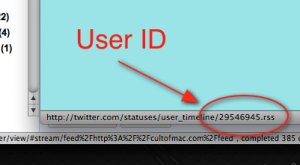 Late last night, former Engadget editor-in-chief Ryan Block tweeted out that he had done some research to attempt to quantify the “Oprah Effect” — that is, the number of users who signed up for Twitter after Oprah featured the service on her show on Friday. The number he came to? 1.2 million.
Late last night, former Engadget editor-in-chief Ryan Block tweeted out that he had done some research to attempt to quantify the “Oprah Effect” — that is, the number of users who signed up for Twitter after Oprah featured the service on her show on Friday. The number he came to? 1.2 million.
So did 1.2 million people actually sign up for Twitter as a result of Oprah? It’s possible, but tracking down this data is a bit tricky. I asked Block what method he used, and he told me he looked at the user ID on a Twitter account from early Friday versus one from the afternoon on Sunday. You see, while most people only know their Twitter name, if you look at the RSS feed for your Twitter account, you’ll see a number assigned to it — that’s your user ID, and Twitter increments it upward as new people sign up.
An account I created just now, for example, has an ID of 33471207. One I created on Friday night (a few hours post-Oprah) had an ID 32779621. Does this mean 700,000 signed up between then and now? Probably not. Twitter has a lot of users, but it does not have 33 million. The reason the user IDs are that high is because Twitter stopped incrementing the number sequentially in March 2007. While it’s not entirely clear what method it switched to, at least one theory had it going back and forth between sequential and increments of 10.
If that pattern is correct — and there isn’t much to suggest that it is, but bear with me — then it would probably make sense to divide any number you get by 5 (half of 10 because it’s not always going up by 10). But, as I noted, my first number was from Friday night. That was a few hours after the show, and likely after many of the new users had finished signing up. So I went back to look at other users who likely signed up around the same time.
Oprah, herself, isn’t a good one to use because while she started tweeting on Friday, her account was actually created in March — 2007, as Twitterholic notes. I’m pretty sure someone else had control of it until about a week ago when Oprah took it over. But Gayle King, editor of Oprah’s O magazine, did sign up right around then. She technically signed up on April 16, the day before the Oprah show. Her ID is 29546945.
 But, remember that Thursday was the crazy race between Ashton Kutcher and CNN to be the first Twitter user with a million followers. It’s likely that a lot of people signed up that day as well, just to join that race. So King’s number isn’t perfect either. But let’s just say that when Oprah started tweeting, the user IDs were probably around 30000000. That means that between then and now it has gone up nearly 3.5 million ID numbers. Divide by 5 and you get 700,000.
But, remember that Thursday was the crazy race between Ashton Kutcher and CNN to be the first Twitter user with a million followers. It’s likely that a lot of people signed up that day as well, just to join that race. So King’s number isn’t perfect either. But let’s just say that when Oprah started tweeting, the user IDs were probably around 30000000. That means that between then and now it has gone up nearly 3.5 million ID numbers. Divide by 5 and you get 700,000.
Again, that’s all contingent on an assumption that Twitter is incrementing the numbers in this odd rotation — which is far from a sure thing. But it’s certainly not doing it entirely sequentially, so it’s not to unreasonable to think that the number of users that signed up between Oprah’s show on Friday and today is somewhere between 500,000 and 1.5 million.
And that’s huge. Almost exactly a year ago, we noted that Twitter likely had somewhere just north of a million total users. The service has exploded in popularity since then, and recent estimates have it somewhere in the 5 to 10 million users range. That means that Oprah may have helped bring on a significant percentage of new users in just a few days. Not that it’s shocking in the least. Yes, some of those users would have signed up anyway, some were there for the Kutcher/CNN showdown, and a lot are likely spam. But a very good chunk are thanks to Oprah.
Naturally, I asked Twitter for some actual numbers to share, and co-founder Biz Stone said they hadn’t planned to release any, but thought it might be interesting, and that he’d look into it this week. So you can probably expect a blog post from him sometime this week, though I’m sure it will be vague, showing spikes in sign-ups in relation to other days — rather than actual numbers.